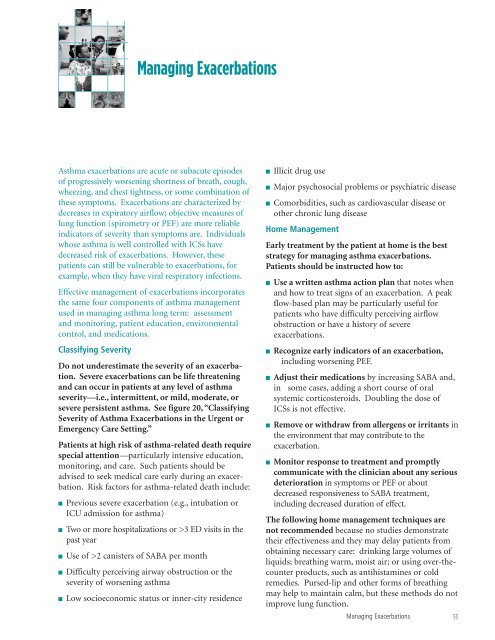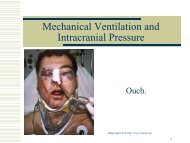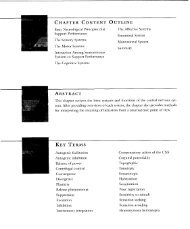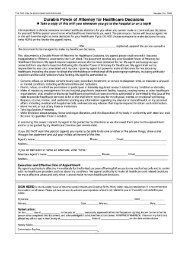Guidelines for the Diagnosis and Management of Asthma
Guidelines for the Diagnosis and Management of Asthma
Guidelines for the Diagnosis and Management of Asthma
You also want an ePaper? Increase the reach of your titles
YUMPU automatically turns print PDFs into web optimized ePapers that Google loves.
Managing Exacerbations<br />
<strong>Asthma</strong> exacerbations are acute or subacute episodes<br />
<strong>of</strong> progressively worsening shortness <strong>of</strong> breath, cough,<br />
wheezing, <strong>and</strong> chest tightness, or some combination <strong>of</strong><br />
<strong>the</strong>se symptoms. Exacerbations are characterized by<br />
decreases in expiratory airflow; objective measures <strong>of</strong><br />
lung function (spirometry or PEF) are more reliable<br />
indicators <strong>of</strong> severity than symptoms are. Individuals<br />
whose asthma is well controlled with ICSs have<br />
decreased risk <strong>of</strong> exacerbations. However, <strong>the</strong>se<br />
patients can still be vulnerable to exacerbations, <strong>for</strong><br />
example, when <strong>the</strong>y have viral respiratory infections.<br />
Effective management <strong>of</strong> exacerbations incorporates<br />
<strong>the</strong> same four components <strong>of</strong> asthma management<br />
used in managing asthma long term: assessment<br />
<strong>and</strong> monitoring, patient education, environmental<br />
control, <strong>and</strong> medications.<br />
Classifying Severity<br />
Do not underestimate <strong>the</strong> severity <strong>of</strong> an exacerbation.<br />
Severe exacerbations can be life threatening<br />
<strong>and</strong> can occur in patients at any level <strong>of</strong> asthma<br />
severity—i.e., intermittent, or mild, moderate, or<br />
severe persistent asthma. See figure 20, “Classifying<br />
Severity <strong>of</strong> <strong>Asthma</strong> Exacerbations in <strong>the</strong> Urgent or<br />
Emergency Care Setting.”<br />
Patients at high risk <strong>of</strong> asthma-related death require<br />
special attention—particularly intensive education,<br />
monitoring, <strong>and</strong> care. Such patients should be<br />
advised to seek medical care early during an exacerbation.<br />
Risk factors <strong>for</strong> asthma-related death include:<br />
■ Previous severe exacerbation (e.g., intubation or<br />
ICU admission <strong>for</strong> asthma)<br />
■ Two or more hospitalizations or >3 ED visits in <strong>the</strong><br />
past year<br />
■ Use <strong>of</strong> >2 canisters <strong>of</strong> SABA per month<br />
■ Difficulty perceiving airway obstruction or <strong>the</strong><br />
severity <strong>of</strong> worsening asthma<br />
■ Low socioeconomic status or inner-city residence<br />
■ Illicit drug use<br />
■ Major psychosocial problems or psychiatric disease<br />
■ Comorbidities, such as cardiovascular disease or<br />
o<strong>the</strong>r chronic lung disease<br />
Home <strong>Management</strong><br />
Early treatment by <strong>the</strong> patient at home is <strong>the</strong> best<br />
strategy <strong>for</strong> managing asthma exacerbations.<br />
Patients should be instructed how to:<br />
■ Use a written asthma action plan that notes when<br />
<strong>and</strong> how to treat signs <strong>of</strong> an exacerbation. A peak<br />
flow-based plan may be particularly useful <strong>for</strong><br />
patients who have difficulty perceiving airflow<br />
obstruction or have a history <strong>of</strong> severe<br />
exacerbations.<br />
■ Recognize early indicators <strong>of</strong> an exacerbation,<br />
including worsening PEF.<br />
■ Adjust <strong>the</strong>ir medications by increasing SABA <strong>and</strong>,<br />
in some cases, adding a short course <strong>of</strong> oral<br />
systemic corticosteroids. Doubling <strong>the</strong> dose <strong>of</strong><br />
ICSs is not effective.<br />
■ Remove or withdraw from allergens or irritants in<br />
<strong>the</strong> environment that may contribute to <strong>the</strong><br />
exacerbation.<br />
■ Monitor response to treatment <strong>and</strong> promptly<br />
communicate with <strong>the</strong> clinician about any serious<br />
deterioration in symptoms or PEF or about<br />
decreased responsiveness to SABA treatment,<br />
including decreased duration <strong>of</strong> effect.<br />
The following home management techniques are<br />
not recommended because no studies demonstrate<br />
<strong>the</strong>ir effectiveness <strong>and</strong> <strong>the</strong>y may delay patients from<br />
obtaining necessary care: drinking large volumes <strong>of</strong><br />
liquids; breathing warm, moist air; or using over-<strong>the</strong>counter<br />
products, such as antihistamines or cold<br />
remedies. Pursed-lip <strong>and</strong> o<strong>the</strong>r <strong>for</strong>ms <strong>of</strong> breathing<br />
may help to maintain calm, but <strong>the</strong>se methods do not<br />
improve lung function.<br />
Managing Exacerbations<br />
53





